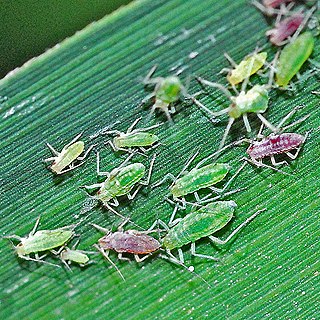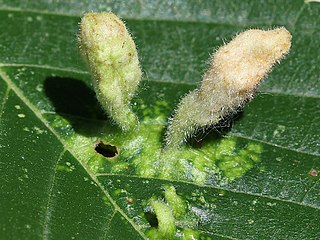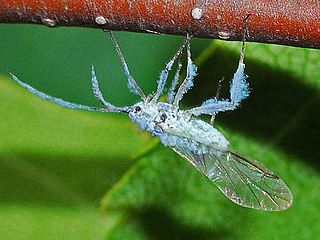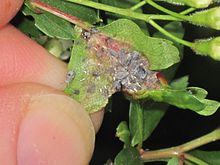
Aphids are small sap-sucking insects and members of the superfamily Aphidoidea. Common names include greenfly and blackfly, although individuals within a species can vary widely in color. The group includes the fluffy white woolly aphids. A typical life cycle involves flightless females giving live birth to female nymphs—who may also be already pregnant, an adaptation scientists call telescoping generations—without the involvement of males. Maturing rapidly, females breed profusely so that the number of these insects multiplies quickly. Winged females may develop later in the season, allowing the insects to colonize new plants. In temperate regions, a phase of sexual reproduction occurs in the autumn, with the insects often overwintering as eggs.

Myzus persicae, known as the green peach aphid, greenfly, or the peach-potato aphid, is a small green aphid belonging to the order Hemiptera. It is the most significant aphid pest of peach trees, causing decreased growth, shrivelling of the leaves and the death of various tissues. It also acts as a vector for the transport of plant viruses such as cucumber mosaic virus (CMV), potato virus Y (PVY) and tobacco etch virus (TEV). Potato virus Y and potato leafroll virus can be passed to members of the nightshade/potato family (Solanaceae), and various mosaic viruses to many other food crops.

Macrosiphum rosae, the rose aphid, is a species of sap-sucking aphids in the subfamily Aphidinae. They have a world-wide distribution and infest rosebushes as the main host in spring and early summer, congregating on the tips of shoots and around new buds. Later in the summer, winged forms move to other rose bushes, or to a limited number of secondary hosts, before returning to rosebushes to lay eggs in the autumn.

Nasonovia ribisnigri is a species of aphid. Their primary hosts are currant plants, including blackcurrants and gooseberries, while the secondary hosts are a wider range of plants, including members of the Compositae, Lamiales and Solanaceae. They are an important agricultural pest in lettuce and endive cultivation.

Aphis gossypii is a tiny insect, an aphid ("greenfly") in the superfamily Aphidoidea in the order Hemiptera. It is a true bug and sucks sap from plants. It is a widely distributed pest of a variety of agricultural crops in the families Cucurbitaceae, Rutaceae and Malvaceae. Common names include cotton aphid, melon aphid and melon and cotton aphid.

The black bean aphid is a small black insect in the genus Aphis, with a broad, soft body, a member of the order Hemiptera. Other common names include blackfly, bean aphid, and beet leaf aphid. In the warmer months of the year, it is found in large numbers on the undersides of leaves and on the growing tips of host plants, including various agricultural crops and many wild and ornamental plants. Both winged and wingless forms exist, and at this time of year, they are all females. They suck sap from stems and leaves and cause distortion of the shoots, stunted plants, reduced yield, and spoiled crops. This aphid also acts as a vector for viruses that cause plant disease, and the honeydew it secretes may encourage the growth of sooty mould. It breeds profusely by live birth, but its numbers are kept in check, especially in the later part of the summer, by various predatory and parasitic insects. Ants feed on the honeydew it produces, and take active steps to remove predators. It is a widely distributed pest of agricultural crops and can be controlled by chemical or biological means. In the autumn, winged forms move to different host plants, where both males and females are produced. These mate and the females lay eggs which overwinter.

Phylloxeridae is a small family of plant-parasitic hemipterans closely related to aphids with only 75 described species. This group comprises two subfamilies and 11 genera with one that is fossil. The genus type is Phylloxera. The Phylloxeridae species are usually called phylloxerans or phylloxerids.
Brachycaudus helichrysi is a species of aphid first described by the German naturalist Johann Heinrich Kaltenbach in 1843. Its common names include leaf curl plum aphid, and leaf-curling plum aphid, and it is a serious pest of plum and damson trees.

Lipaphis erysimi is a species of aphid of the family Aphididae. Its common names include mustard aphid and turnip aphid. It is found in most temperate and tropical areas of the world and feeds only on cruciferous plants. The insects are almost exclusively female and are very prolific, with wingless females producing around one hundred young during a lifespan of a few weeks.

Megoura viciae is a large, green aphid in the family Aphididae native to Europe that feeds on plants in the genus Vicia. They are commonly known as vetch aphids for this reason.
Cinara confinis, the black stem aphid, is a species of aphid in the genus Cinara, found feeding on the twigs of various species of fir (Abies) and on several other species of coniferous trees. This aphid has a Holarctic distribution and is known from Europe, Asia, North America and Argentina.

Aphis pomi, commonly known as the apple aphid, or the green apple aphid, is a true bug in the family Aphididae. It is found on young growth of apple trees and on other members of the rose family where it feeds by sucking sap. Reproduction is mainly by parthenogenesis, in which unmated females give birth to live young.

Brachycaudus cardui is a species of aphid, commonly known as the thistle aphid or the plum-thistle aphid. It infests trees in the genus Prunus in the spring and autumn, and mostly plants in the aster family in the summer.

Hyalopterus pruni, the mealy plum aphid, is an aphid in the superfamily Aphidoidea in the order Hemiptera. It is a true bug and sucks sap from plants.

Rhopalosiphum rufiabdominale, the rice root aphid or red rice root aphid, is a sap-sucking insect pest with a wide host range and a global distribution. As a member of the superfamily Aphidoidea, it is one of 16 species of the genus Rhopalosiphum. Adults and nymphs are soft-bodied and usually dark green with brown, red, or yellow tones. Like all aphids, reproduction is sexual and asexual, depending on the environmental conditions and host plant. Rice root aphids cause injury to external plant parts, namely the roots or stem, by feeding on plant sap and vector several important plant viruses. The hosts of this pest extend across multiple plant families with most belonging to Rosaceae, Poaceae, and Solanaceae. R. rufiabdominale is universally associated with Prunus species but also infests various field crops, greenhouse vegetables, cannabis, and other ornamental plants. While this aphid originates from east Asia, it spans nearly every continent. Dispersal is particularly widespread across the United States, India, and Australia, with crop damage documented in multiple instances, although economic losses are primarily associated with Japanese rice crops. Nonetheless, it remains a pest of serious concern due to its high mobility, discrete habitat, and adaptive plasticity, giving it the rightful reputation as a successful invader.

Eriosoma lanigerum, the woolly apple aphid, woolly aphid or American blight, is an aphid in the superfamily Aphidoidea in the order Hemiptera. It is a true bug and sucks sap from plants.

The oriental grass root aphid, Tetraneura akinire, is an aphid in the superfamily Aphidoidea in the order Hemiptera. It is a true bug and sucks sap from plants.
Colophina clematis is a species of aphid in the woolly aphid subfamily, Eriosomatinae, native to Japan. This woolly aphid has the distinction of being the first species of aphid to have been identified as having a "soldier" caste. First instar nymphs of this type are able to protect the aphid colony, killing the larvae of predatory ladybirds, hoverflies and the flower bug Anthocoris nemoralis.

Phyllaphis fagi, the woolly beech aphid, is a species of aphid in the family Aphididae.

Tetraneura ulmi, the elm sack gall aphid and also known as a fig gall, is a species of aphid in the family Aphididae. It was described by Carl Linnaeus and named in his Systema Naturae, published in 1758. The mite is found in Asia, Europe and North America, causing abnormal plant growths, known as galls on their primary host, elm trees (Ulmus species). They feed on a secondary host, the roots of various grasses.

















